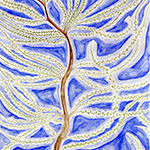The works of artist Yesmine Ben Khelil (Tunis, 1986) focus on the reappropriation of images, texts or objects in order to create narratives that conflate official, particularly colonial ones. Her works—drawings, collages, installations, and paintings—often spring from elements drawn from reality to explore ancient folk beliefs, myths and legends that are woven into the world we live in. Her artistic research not only questions anthropocentric perspectives, but also seeks to redefine the relationship between humans and the natural world, proposing alternative narratives where the nonhuman is not subordinate but coexists in a complex balance.
During a residency period in Bergamo, Ben Khelil had the chance to explore the city’s natural and cultural heritage, and learn about the Botanical Garden of the Città Alta. Among the species found here and deeply rooted in Bergamo’s urban landscape, the artist recognized the acanthus: a perennial herbaceous plant that also grows wild in Tunis, her hometown.
Acanthus mollis (bear’s breeches), which is widespread in arid and bushy places throughout Southern Europe and North Africa, is distinguished by its broad, lobed, bright green leaves, grouped into a basal rosette from which a flowering spike rises in the spring-summer period. In Greek mythology, Acanthus was a nymph who, in order to resist Apollo’s sexual assault, scratched his face and for this impudence was transformed into the plant of the same name, one suited to shade yet which still needs sun to live, and later became a symbol of virginity. Despite being classed as an ornamental plant, the acanthus possesses an invasive nature. Its name, which comes from the Greek for “thorn,” seems to evoke a threatening aspect, and yet in the language of flowers expresses inseparability.
The acanthus is at the same time seductive and “fierce,” cultivable yet hard to keep under control. The plant itself seems to challenge any attempt at division, forcefully stating that nothing may separate it from what it is bound to. The contradictions that this plant seems to bring with it and its spread throughout the Mediterranean are the pretext for the artist to draw a parallel with the human dynamics that affect these areas and to reflect on the complex relationship between the southern and northern shores of the Mediterranean Sea.
The pictorial installation conceived by the artist, and staged in collaboration with the Orto Botanico “Lorenzo Rota”, is set along the glazed perimeter of the Winter Garden pavilion. The artwork reflects on the symbolic meanings attributed to the plant, mixing past and present, reality and fiction, history and stories, as well as only apparently distant geographies.
The installation, entitled Rien ne pourra nous separer / Nothing will separate us, is made up of a series of paintings produced on fine cotton canvas, thus allowing the light to shine through them and at the same time for the surrounding landscape to be partially viewable.
Using the acanthus and its strong roots as a metaphor for the complex cultural and migratory dynamics that characterize the Mediterranean, the artist builds a cultural and symbolic bridge, a dialogue between different places and cultures, highlighting how nature may provide an element of connection and mutual understanding.
Press release from GAMeC
Image: Yesmine Ben Khelil. Carnet chrysanthème 7. 2021. 40,2 x 29,7 cm. Colored pencil on paper. Image courtesy of the artist



